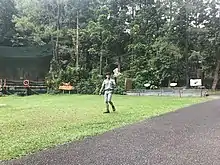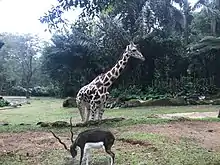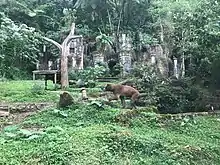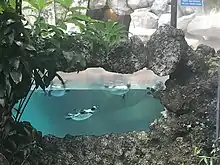Taman Safari
Taman Safari Indonesia or simply Taman Safari are animal theme parks in Cisarua, Prigen, and Bali. Being part of the same organization, they are known as Taman Safari I, II and III. The most popular is Taman Safari I.[4]
 | |
| Date opened |
|
|---|---|
| Location | |
| Coordinates | 6.7203156°S 106.9505096°E |
| No. of animals | 3000 |
| Memberships | WAZA,[2] SEAZA,[3] CBSG, and PKBSI |
| Website | www.tamansafari.com |


Taman Safari I
Taman Safari I, or called as Taman Safari Bogor, is located at district Cisarua, on Bogor regency, on the old main road between Jakarta and Bandung, West Java. It is roughly 80 kilometres (50 mi) from Soekarno-Hatta International Airport, Jakarta and 78 kilometres (48 mi) from Bandung. Taman Safari is located on Puncak, a tourist area in West Java.
Taman Safari I covers an area of 170 hectares (420 acres)[5] and houses a collection of more than 3,000 animals, including Bengal tigers, Malayan sun bears, giraffes, orangutans, hippos, zebras, and Sumatran elephants. Some, such as the Bali myna, are involved in conservation projects. The majority of the species represented are African.[6]


Nine shows are offered, that is the Elephant Show, Safari Theater, Various Animals Show, Tiger Show, Sea Lion Show, Bird of Prey Show, Dolphin Show, Cowboy Show, and The Globe of Death.[7]
Near the Wild Wild West, visitors can see the Jaksa Waterfall. To reach this waterfall, visitors can use the road train or walking about 500 meter. The height of the Jaksa Waterfall reaches 45 meters. Under the fall there is also a pool that is not too deep so that children can play in the water. The water of Jaksa Waterfall comes from the foot of Mount Gede Pangrango. If lucky, visitors can also see native wildlife, including several primates and birds. According to local legends, if someone who come to wash their face with Jaksa Waterfall's water, it will make them easier to find a mate, stay young, and make their sustenance easier. For other facilities, Taman Safari provides canteen and changing room.[8]
Every week night or holiday night, visitors can explore the Safari Journey at night with a road train accompanied by guides. Near the end of the trip, visitors can watch the Spectacular Light Dance, where the performers will perform fire performances.[9] The zoo's Javan warty pig can only be seen in the Night Safari. The Night Safari is currently closed.
Every weekend and holiday, visitors can hike around the forest surrounding the park. Before starting to hike, visitors are guided by a guide to do exercises. Visitors accompanied by guides during the hike. visitors are taught about medicinal plants by the guide, see the Sumatran porcupine and Malayan porcupine exhibits, see native wildlife from a distance, visit the Javan leopard and Javan rusa breeding facility, and visit an abandoned colonial era house. At the end of the hike, visitors can enjoy several games.[10]
History
Taman Safari I was built on 1980 on 50 hectares of unproductive plantation land. On 1990, the park was named as a National Tourism Object by Soesilo Soedarman, the Minister of Tourism, Postal, and Telecommunication at that time.
The park used to exhibit two polar bears named Bjurn and Tasha delivered from Adelaide Zoo after a breeding program in 1992. However, Bjurn died on March 31, 2004 while Tasha died on March 30, 2008, both due to old age. The exhibit is now used as a Humboldt penguin exhibit, the polar bears can be seen as a taxidermy in the exhibit. The polar bears was originally a wild caught from Siberia and then sent to Ruhr Zoo, the pair then sent into Adelaide Zoo.
In February 2012, Taman Safari saved a Sumatran tiger in Riau, named Bimo. Bimo's body condition was wet with oil, his eyes were open and helpless, it was suspected that Bimo was poisoned. At the time of capture, the male tiger, estimated to be four years old, had a wound on his toenail. After being treated for three days, Bimo has begun to roar, but has not been able to sit normally. So the rescue team decided to take Bimo to the Taman Safari's animal hospital. Bimo's condition gradually improved after receiving intensive care. Although Bimo cannot be released into the wild, Bimo can contribute to the genetic preservation of Sumatran tigers with the Sumatran Tiger Captive Breeding and Genome Resource Bank program conducted by Taman Safari. Now, Bimo's reproductive condition has improved, and currently Bimo has three children named Praja, Binsar, and Bulan from brooders named Cut Nyak. Cut Nyak is a female tiger also originating from the wild, more precisely in Aceh, because it is suspected to be a man eater.[11]
Taman Safari is one of two Indonesian zoo that keep the snow leopard, the other is Batu Secret Zoo. Taman Safari keep couple named Omar and Sayan since 2012 until 2019. Taman Safari's snow leopards came from Tierpark Berlin. The male Omar born on June 1, 1999, while the female Sayan born on Mei 25th 1996. They passed away in the early 2020. The exhibit is empty for several months until it was reused as a cougar exhibit in 2020.[12]
From 2013 to 2018, Taman Safari Bogor keep a liger named Nala. He was discovered by the authority in a fancy villa in Bogor, it is suspected that Nala was a result of an illegal breeding program carried out by the exotic animals syndicate. Nala's mother was a lion and father was a tiger. They later send Nala to Taman Safari Bogor. Nala was first used as a photo prob, later they decided to create a India themed exhibit at the Baby Zoo for Nala. Nala is a big male liger and weigh around 700 to 800 pounds. There is no information whether or not Nala died or put off display. Nala's exhibit now houses a male white lion named Link, alongside other white lions, delivered from Canada in 2018. Nala is currently the only liger known in Indonesia.[13]
In September 2017, Taman Safari introduced two giant pandas named Cai Tao (蔡涛) and Hu Chun (胡春). Cai Tao and Hu Chun were born at the Bifengxia Panda Base in Bifengxia, Ya'an, Sichuan, China. The arrival process of Cai Tao and Hu Chun had been carried out for a long time, marked by the construction of the "Panda Palace" which would later become their home in Taman Safari. Cai Tao and Hu Chun have traveled more than 4,400 kilometers, taking off from Shuangliu International Airport in Chengdu, China on September 28, 2017, traveling five and a half hours until arriving at Soekarno–Hatta International Airport. After undergoing an adjustment period of approximately two months, the two of them finally began to be displayed in November 2017. In front of Panda Palace are two replica statues of Cai Tao and Hu Chun welcoming the visitors. Panda Palace is also equipped with several facilities including the food court and souvenir store. To avoid noise caused by vehicles, visitors must take a bus to go to the Panda Palace.[14]
Safari Journey




Visitors are encouraged to drive through the park and it is possible to come within touching distance of most of the animals. Some areas allow for guests to feed animals from their cars. Guests are not allowed to feed carnivores, and the area that showcase carnivores such as tigers and lions are monitored by the warden. Guests are not allowed to step out from the car. Guests that didn't own cars may see the safari areas from buses that are run on schedule. Sometimes, many crab-eating macaque and Javan myna can be seen roaming the Safari area, this animals are native to the forest of Mount Pangrango.
- Greater flamingo
- Sumatran elephant
- Javan muntjac
- Bawean deer
- Malayan tapir
- Ankole-Watusi
- Hippopotamus
- Dromedary camel
- Bactrian camel
- Black crowned crane
- Chital
- Javan rusa
- Sambar deer
- Nilgai
- Malayan sun bear
- Lesser adjutant
- Muscovy duck
- Alabio duck
- Little black cormorant
- Siamang
- Llama
- Sitatunga
- Chital
- Blackbuck
- African leopard
- African black panther
- Reticulated giraffe
- Rothschild's giraffe
- South American cougar
- Binturong
- Sumatran porcupine
- Malayan porcupine
- White bellied sea eagle
- Blue wildebeest
- Ankole-Watusi
- Pygmy hippo
- Asian small-clawed otter
- Chapman's zebra
- Common eland
- Chital
- Blackbuck
- Reticulated giraffe
- Rothschild's giraffe
- Lowland anoa
- Red lechwe
- Llama
- European bison
- North Sulawesi babirusa
- African lion
- Bengal tiger
- White tiger
- Southern white rhinoceros
- Nyala
- Chapman's zebra
- Blue wildebeest
- Barbary sheep
- Defassa waterbuck
- South African ostrich
- Hippopotamus
- Saltwater crocodile
- Sumatran tiger
- Eurasian brown bear
- Impala
- Emu
- Southern cassowary
- Bornean orangutan
- Scimitar oryx
- Dusky pademelon
- Javan banteng
- Capybara
- Malayan sun bear
Bird aviary

- Bali myna
- Lesser bird of paradise
- Red bird of paradise
- Twelve-wired bird of paradise
- Chattering lory
- Black-capped lory
- Coconut lorikeet
- Rose-ringed parakeet
- Eclectus parrot
- Goffin's cockatoo
- Sulphur-crested cockatoo
- Salmon-crested cockatoo
- Pied imperial pigeon
- Nicobar pigeon
- Western crowned pigeon
- Buffy fish owl
- Wreathed hornbill
- Papuan hornbill
- Rhinoceros hornbill
- Large flying fox
- Helmeted guineafowl
- Black-backed swamphen
- Great argus
- Javan peafowl
- Blue peafowl
- Muscovy duck
- Wandering whistling duck
- Magpie goose
- Australian pelican
- Little black cormorant
- Purple heron
- Black-crowned night heron
- Eastern cattle egret
- Black-headed ibis
Baby zoo
For a small fee, visitors can take a photo with baby animals, snakes or birds. Visitors currently aren't allowed to take photos with the animals.
Australian Outback and Big Cat Center
Crocodile Park
Bird of Prey
Komodo Dragon Island
Kampung Papua (Papua Village)
Primate Center
Leaf Eater Monkey
Reptile tunnel and Nocturnal House (Including a freshwater aquarium)
- Balinese palm civet
- Asian palm civet
- Small Indian civet
- Red giant flying squirrel
- Masked palm civet
- Pacific barn owl
- Sugar glider
- Sulawesi dwarf cuscus
- Redtail catfish
- Tambaqui
- Alligator gar
- Arapaima
- New Guinea snapping turtle
- Malaysian giant turtle
- Albino cobra
- Texas rat snake
- Ball python
- Green iguana
- Blue tree monitor
- Indian star tortoise
- Albino milk snake
- Green tree python
- Javan spitting cobra
- D'Albertis python
- Papuan olive python
- Sunbeam snake
- Malayan krait
- Water python
- Corn snake
- Red-tailed boa
- Green tree monitor
- Leucistic cobra
- Malayan pit viper
- Reticulated python
- Merauke blue tongue skink
- Reticulated python
- Green Iguana
- Albino python
- Amboina sailfin lizard
- Yellow anaconda
- Two-striped water monitor
- Reticulated python
- King cobra
Kalimantan Pavilion
Japan Pavilion
Swimming With Dolphin
Visitors currently aren't allowed to swim with the dolphins
Wild Wild West
Istana Panda (Panda Kingdom)
Miscellaneous
A aquarium located in the park's ticket counter and gift shop housed several alligator gar. There is also a aquarium located at the park's food court, a promotion for Jakarta Aquarium, a subsidiary of Taman Safari, housing several angelfish and kamfa flowerhorn. Located at the edge of the park's amusement park, there is an exhibit for red-and-green macaw, blue-and-yellow macaw, sulphur-crested cockatoo, and salmon-crested cockatoo. At the park's water park, visitors can swim through a tunnel with two glassed exhibit housing saltwater crocodile and Asian small-clawed otter. When exiting the Sea Lion Show, visitors can see a saltwater aquarium housing a single harbor seal. A exhibit located at the entrance of Komodo Dragon Island housed two variety of binturong and Sunda porcupine. Near the Reptile Tunnel entrance, there is three exhibits, housing Asian forest tortoise, meerkat, and mandrill.
Show animals
Animals that can only be seen in one of the shows.
Taman Safari II
Taman Safari II is a branch of Taman Safari located in Prigen, Pasuruan, East Java (7.761171°S 112.66722°E). It is about 50 kilometres (31 mi) from Juanda International Airport, Surabaya and about 45 kilometres (28 mi) from Malang. It lies on the slope of Mount Arjuno, 800 to 1,500 metres (2,600 to 4,900 ft) above sea level and covers about 350 hectares (860 acres), making it become the largest Safari Park in Asia.[5]
The safari area showcase four different zone, which is the America-Europe zone, carnivore zone, Asia Zone, and Africa zone. The America-Europe zone showcase animals from North and South America and Europe such as llama, turkey, and bison. The zone also have an empty exhibit near the end of the zone, which formerly houses a maned wolf. The carnivore zone showcase three large carnivores such as brown bear, Bengal tiger, and African lion. The Asia zone showcase animals from Indonesia, India, and the Himalayas such as sun bear, Komodo dragon, Asian black bear, orangutan, Javan leopard, Malayan tapir, saltwater crocodile and banteng. The Africa zone showcase animals from Africa like giraffes, plains zebra, gnu, and white rhino , this zone also showcase non-African animals such as pelican, dromedary camel, and Sumatran elephant.
The baby zoo of Taman Safari II have more diverse animals to take a photo with than Taman Safari I. This part of the park also have several exhibits for white lion, Sumatran tiger, crocodile, porcupine, mandrill, proboscis monkey, tarsier, orangutan, and chimpanzee. The area also include several exhibits such as the bird aviary, reptile park, and the big cats exhibits. Aquatic Land located at the edge of the baby zoo, this exhibits houses aquatic animals such as the Humboldt penguin, harbor seal, American beaver, and pygmy hippo.
The park have an Australia themed zone named Australiana. The exhibit showcase animal such as gray kangaroo, red-necked and agile wallaby, black swan and wombat. The indoor wombat viewing area also include herpetarium for Australasian reptiles such as bearded dragon, carpet python, and blue-tongued skink, this part of the zone also showcase non-Australian animals such as reticulated python, Malayan porcupine, and large flying fox. The park planned to add koala to the exhibit in the future. Some of the animals came from Australia zoo. The original Australia zone houses red kangaroo located in the baby zoo.
There is an dolphinarium with a stage that contains Indo-Pacific bottlenose dolphins. They also have a dolphin show there. Visitors once could swim with dolphins before the COVID-19 pandemic
Prigen Conservation Breeding Ark (PCBA) is a breeding facility owned by Taman Safari II for different type of song birds, such as hill myna, Javan green magpie, Sumatran laughingthrush, and white-eye. Other animal that the facility breed are Javan small-toothed palm civet and Javan warty pig. The facility planned to breed betta burdigala and parosphromenus ornaticauda in the future.
Bali Safari and Marine Park
Bali Safari and Marine Park is a branch of Taman Safari located in Marina Beach in Bali.[15] In December 2019, the zoo introduced striped hyena.
Batang Dolphin Center
Batang Dolphin Center is a branch of Taman Safari located in the Sigandu beach, Batang Regency, Central Java[16] The park mainly focus on bottlenose dolphin, but the park also have other animal exhibits like sea turtles touch pool, mini safari, bird aviary, reptile exhibits, and freshwater aquarium.
Jakarta Aquarium
Jakarta Aquarium is located inside the Neo Soho mall, Jakarta. The aquarium have saltwater, freshwater, brackish, and land animals from around the world. Right next to the gift store, there is a restaurant named Pingoo. Where visitors can eat their meals with a Humboldt penguin
Criticism
The company came under fire in April 2016 for its alleged practice of drugging wild animals in order to utilise them as props in photographs with tourists. The company stated the pictured lion had not been drugged and was 'just sleepy'.[17]
In November 2017, two visitors gave an wine to the blackbucks and hippo. One of them rule the animals with carrots, as they reach the carrots the visitors quickly pour the wine to the animals mouth while the other laughed and share it on their Instagram story.[18]
References
- "What is Taman Safari Indonesia". tamansafari.com. Taman Safari Indonesia. Retrieved 7 April 2011.
- "Zoos and Aquariums of the World". waza.org. WAZA. Retrieved 31 March 2011.
- "SEAZA Membership List". seaza.org. SEAZA. Retrieved 31 March 2011.
- http://www.searchindonesia.net/national-parks-and-museums/taman-safari.html
- "Taman Safari Prigen Kejar Target Pengunjung". Tempo. 22 June 2012.
- zoo_conservation
- https://bogor.tamansafari.com/edukasi.php
- https://travel.detik.com/domestic-destination/d-4316103/indahnya-curug-jaksa-di-bogor-yang-dipercaya-bikin-enteng-jodoh
- https://bogor.tamansafari.com/malam.php
- https://www.instagram.com/p/CERfULiAwRn/
- https://twitter.com/TSI_Bogor/status/1288350715346169856
- https://www.zoochat.com/community/threads/snow-leopard-in-indonesia.478438/
- https://www.zoochat.com/community/threads/nala-the-liger.478437/
- https://rmco.id/baca-berita/ekonomi-bisnis/23302/menikmati-wisata-edukasi-istana-panda-di-taman-safari-bogor
- "PT Taman Safari Indonesia III". blogspot.com. Career Development Center. Retrieved 7 April 2011.
- "Mengenal Batang : Potensi Batang Dolphin Center | Website Pemerintah Kabupaten Batang". www.batangkab.go.id.
- "Taman Safari denies drugging photo prop lion, says it was just sleepy | Coconuts Jakarta". Coconuts. 7 April 2016.
- "Heboh Hewan Taman Safari Indonesia Diberi Alkohol, 5 Perlakuan Pada Hewan ini Nggak Kalah Biadab!". TribunStyle.com.
External links
| Wikimedia Commons has media related to Taman Safari Indonesia. |
